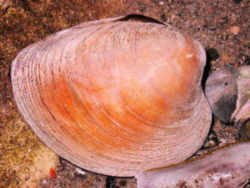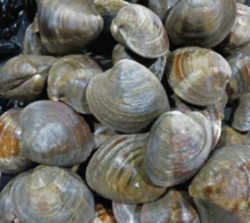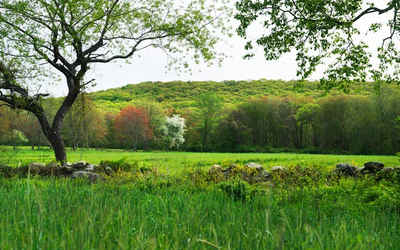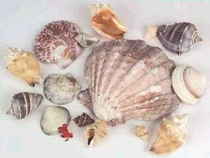Rhode Island State Shell
Quahaug

(Mercenaria mercenaria)
Adopted on Jun 30, 1987.
The Quahaug, (Mercenaria mercenaria,) was adopted as Rhode Island's official state shell on June 30, 1987. The word quahog comes from the Narragansett Indian name: poquauhock. The quahog's scientific name, Mercenaria mercenaria, is derived from a Latin word meaning "wages." The Native Americans used quahog shells to make beads that they used as money (wampum).
Rhode Island State Shell: Quahaug

The word quahog comes from the Narragansett Indian name: poquauhock. The quahog's scientific name, Mercenaria mercenaria, is derived from a Latin word meaning "wages." The Native Americans used quahog shells to make beads that they used as money (wampum.
In 1987, Kay Peterson was a member of the American Malacological Union and Conchologists of America, president of the Boston Malacological Club, and program chairman of the Shell Club of Mystic, Connecticut, and affiliated with the Coventry, Rhode Island Junior High School Shell Club ask members of the Junior High Shell Club if they would like to get Rhode Island to adopt a state shell."
Narrowing their search to the quahaug, a hard-shelled clam whose shells were used as wampum ("money") by Native Americans.
Common Name
Northern quahog, hard clam, cherrystone, littleneck
Characteristics of the Quahaug
The hard clam or northern quahog (Mercenaria mercenaria) has two valves of equal size with an ovate-trigonal shape (Eversole 1987). An external ligament joins the two valves, and obvious growth lines radiate concentrically from the umbo. These concentric ridges are sharp in young clams, but become smooth and irregular with age (Weiss 1995). The shell is off-white to fawn colored with a thin periostracum, and the shell interior is white or pale yellow with purple markings. Northern quahogs have two short siphons, the tips of which range in color from white to black, and a ring of small tentacles surrounds the incurrent siphon. The quahog's foot is proportionately large and hatchet shaped. The Mercenaria mercenaria, burrows shallowly in sediments of either mud or sand. It is among the most commercially important species of invertebrate. Like other clams, it is a filter feeder.
Can be confused with the Southern hard clam, M. campechiensis which closely resembles M. mercenaria. However, M. campechiensis is slightly larger, and its shell lacks purple coloration on the interior surface. It also lacks any smooth areas near its umbo.
Locomotion
Mercenaria has limited locomotion in that it is able to burrow via use of its muscular foot; however, they are generally sedentary if left undisturbed
Feeding
Hard clam larvae, juveniles, and adults consume phytoplankton, zooplankton, and detrital material by trapping particles in the mucus lining of their gills (Grosslein and Azarovitz 1982, Chesapeake Bay Program 1987). They are also able to absorb dissolved organics directly from the water (Eversole 1987). Water is brought through the inhalant siphon and passed over the gills where the food particles are captured and transported to the mouth via cilia. The particles pass through the digestive system, and waste is released through the exhalant siphon in the shape of rod-shaped fecal pellets (Eversole 1987).
Life Cycle
Spawning occurs when males and females release gametes into the water column during the summer months, as water temperatures reach approximately 22 to 24 degrees Celsius (Chesapeake Bay Program 1987). Eggs are buoyant and have a diameter of 0.07 millimeters plus an outer envelope 0.03 to 0.1 millimeters thick. Fertilization occurs in the water column followed by development into planktonic larvae. The larvae pass through various developmental stages, marked by the formation of shell valves, umbo, and ciliated foot. After approximately four weeks of development, settlement occurs with the larvae attaching to sand grains and taking up a benthic lifestyle. During this stage, the siphons develop, the mantle fuses, and the shell develops ridges. As the juveniles grow, they burrow into the sediment, maintaining contact with the surface using only the siphon (Eversole 1987). Prior to sexual maturity, hard clams go through a hermaphroditic stage (occurring at 6 to 7 millimeters in length) having both male and female gonadal cells while functioning mostly as males (Eversole 1987). At the end of this stage they become either male or female and reach maturity by age two and at lengths of 3.2 to 3.8 centimeters. Hard clams in the south reach maturity in about one year, while their northern relatives mature in two years, thus sexual maturity in northern quahogs is dependent on size rather than age (Eversole 1987). In their first 5 to 6 years, quahogs can reach sizes of 5 to 6 centimeters (littleneck) and reach their maximum length of 15 centimeters at an estimated 20 years.
Distribution
Northern quahogs are distributed along the eastern and Gulf coasts of the US, ranging from the Gulf of St. Lawrence to Florida and into Texas (Grosslein and Azarovitz 1982, Eversole 1987). It is most abundant from Virginia to Massachusetts (Eversole 1987) and has also been introduced to California and Europe.
Hard clams inhabit the subtidal regions of bays and estuaries to approximately 15 meters in depth (Eversole 1987). They are generally found in firm
bottom areas consisting of sand or shell fragments (Chesapeake Bay Program 1987), optimal settling substrates for juveniles (Eversole 1987). Franz
and Harris (1988) identified northern quahogs as fine-sand species in Jamaica Bay.
Culinary Discovery: The Tastes of Rhode Island
Clams come four different ways in Rhode Island: clam cakes, chowder, baked and stuffies. Clam cakes are deep fried fritters the size of golf
balls made up of chopped clam and flour. They are often overloaded with grease and so nicknamed 'sinkers' since they sink to the bottom of your stomach.
Clam chowder is a New England staple with its creamy, potato base. There are two other varieties: Manhattan, made with a tomato base and the true,
authentic Rhode Island version, made from a clear broth with clams in it.
A true sign of the end of summer is the clambake. Usually it's a large gathering of people reaping the benefits of a few companions building a sand
oven and steaming clams, mussels, lobsters, corn and potatoes in seaweed under hot rocks all day.
The fourth way to prepare clams is to stuff and bake them. Generally the quahog is used but littleneck clams can be stuffed and are perfect for cocktail
parties. Whatever the size, they are usually made by mincing clam meat and mixing it with an onion, breadcrumbs and spices. Oh, and of course clams
can always come in the form of steamers, fried strips, and raw.
Rhode Island Quahog Chowder
3 pounds red bliss potatoes 1/2-inch dice
Water, to cover
4 teaspoons white pepper
4 teaspoons salt
3/4 pound ground salt pork
1 Spanish onion, diced
2 cups chopped quahogs
2 cups quahog juice
4 teaspoons tablespoon fresh thyme
Place potatoes in a large pot, cover with water by 2 inches. Add salt and pepper, bring to boil then reduce to a simmer. Meanwhile, heat the salt pork
in a large skillet, add the onion and saute until the onions are translucent. Then add onions and pork to the simmering potatoes. Then add quahogs,
quahog juice, and thyme. Simmer for 30 minutes or until potatoes are cooked through.
Makes: 15 portions
Clam Cakes
2 eggs
1/2 cup clam juice
1/2 cup milk Pepper
1 1/2 cup flour
salt
2 teaspoons baking powder
8 oz. can minced clams
oil for deep frying
Beat eggs until light and frothy in a medium bowl. Add milk and clam juice and stir to combine. Sift flour, baking powder, salt and pepper. Add the
minced clams to the flour mixture then add enough of the liquid to make a thick batter. Drop batter one teaspoon at a time into 375 degree oil. The
cakes will flip over by themselves once one side is cooked. Drain on paper towels. Serve immediately.
Gabriella True has had a passion for cooking since the day her Mom let her pound down the freshly risen dough created from her Grandmother's bread
recipe. In fifth grade she chose Julia Child as her hero to write about in English class. Growing up in the heart of New York City she was able to
avidly explore the foods of the world. Since then she has catered small parties and spent hours writing and testing recipes to share with her loyal
audience. She began writing about food, its culture and history through her association with Splendid Palate. You can contact the author directly via
email at Gabriella@splendidpalate.com
Rhode Island Law
The law designating shellfish, commonly known as the "quahaug" as the official Rhode Island state shell is found in the State of Rhode Island General Laws, Title 42, Chapter 1042-4, Section 42-4-12
TITLE 42
State Affairs and Government
CHAPTER 42-4
State Emblems
SECTION 42-4-12
§ 42-4-12 State shell. - The shellfish, commonly known as the "quahaug" (mercenaria mercenaria), is hereby designated as the state shell
for the state.
History of Section.
(P.L. 1987, ch. 321, § 1; P.L. 1987, ch. 450, § 1.)
Taxonomic Hierarchy: Quahaug
Kingdom: Animalia - animals
Phylum: Mollusca
Class: Bivalvia
Order: Veneroida
Family: Veneridae
Genus: Mercenaria
Species: Mercenaria mercenaria (Linnaeus, 1758)








